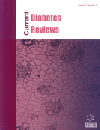
Full text loading...
We use cookies to track usage and preferences.I Understand
Type 2 Diabetes Mellitus (T2DM) is a chronic metabolic disorder characterized by chronic hyperglycemia, which often co-exists with other metabolic impairments. This condition can damage various tissues and organs, resulting in the development of severe complications, both microvascular, such as retinopathy, nephropathy, and neuropathy, and macrovascular, responsible for an increased risk of cardiovascular diseases. Curcumin is the main bioactive molecule found in the rhizomes of turmeric. Many studies have reported curcumin to exhibit antioxidant, anti-inflammatory, anti-infectious, and anti-cancer properties; thus, there is an increasing interest in exploiting these properties in order to prevent the rise or the progression of T2DM, as well as its possible associated conditions. In this review, we have presented the current state-of-art regarding the clinical trials that have involved curcumin administration and analyzed the possible mechanisms by which curcumin might exert the beneficial effects observed in literature.

Article metrics loading...

Full text loading...
References


Data & Media loading...

